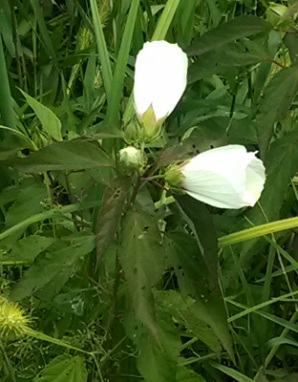
To plan your visit to the Phinizy Swamp, check out:
http://www.phinizyswamp.org/
(The Southeastern Natural Sciences Academy has changed its name to the Phinizy Center for Water Sciences.)
| Priscilla Hollingsworth |
|
|
Also called Swamp Rose Mallow or Rose Mallow. This plant is in the Hibiscus genus, and it contains various species that often hybridize with each other, and that can make exact designations hard to define. Hibiscus moscheutos and Hibiscus coccineus seem to be the commonest swamp mallow species names.  Some of these varieties have white, pink, or red flowers, but ours in the Phinizy Swamp are all white. The plants prefer moist, rich soil, and can grow in standing water. They tend to be salt-resistant. Swamp mallow grows wild from Texas up through the Southeastern and Atlantic states to southern Ontario. The swamp mallow plant needs lots of sun, and likes hot summers. Each flower is open for one day. I really like the curving spiky projections around the base of the flower and buds, as well as the geometry of the buds and seed pods. There is a rose mallow bee that only pollinates this plant – it eats both the pollen and the nectar. It looks a lot like a bumblebee, and its official name is Ptilothrix bombiformis. It’s possible that the rose mallow bee is what is working on the stamen of the swamp mallow flower in this photo (the bee has been seen in our region), though it’s really hard to tell since the photo doesn’t have enough detail. Why is it called a mallow? It looks a lot like the Althaea officinalis plant, which is also called the marsh mallow plant. The roots of marsh mallow plants have a thick, goopy substance (similar to the juice of okra pods) which can be extracted and used for medicinal purposes – and also, when cooked with sugar and water, to make the type of candy which became known as “marshmallow”. Later, marshmallow candy was made with egg whites as a substitute for the gel of the marsh mallow plant. I haven’t broken a swamp mallow plant to see if it contains a gel. Above: a mass of swamp mallow plants in the swamp. This area is often underwater.
To plan your visit to the Phinizy Swamp, check out: http://www.phinizyswamp.org/ (The Southeastern Natural Sciences Academy has changed its name to the Phinizy Center for Water Sciences.)
0 Comments
Leave a Reply. |
Categories
All
AuthorPriscilla Hollingsworth, artist. Categories
All
|